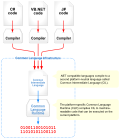.NET Framework
.NET Framework (pronounced dot net) is a product of Microsoft. It is a programming framework used by Software applications in order to run.[1] It has two major parts: the Common Language Runtime (CLR) and the .NET Framework Class Library. The CLR is an execution engine used to handle running programs. The class library provides a library of reusable code that applications can use.[2] These are designed to greatly simplify the development of larger applications.[2] .NET Framework supports Object-oriented programming (OOP).[3] Everything in .NET is contained in an object.[3] It also greatly simplifies Windows programming.[3]
Often, a program will ask for a particular version of .NET Framework to be installed (see below).[4] It is usually recommended to install the latest version your operating system (OS) will support.[4] This is because of backward compatibility; the newer version will also support older versions.
Visual Studio is the major development tool for .NET Framework. Visual Studio 2013 Community Edition is the first full-featured edition for personal development. It also has compilers for computer programming languages such as C++ and others.
Version
| Version | CLR | Release date |
Shipped With Visual Studio |
Comprising Components of Windows | Embraces | |
|---|---|---|---|---|---|---|
| Client | Server | |||||
| 1.0[0] | 1.0 | February 13, 2002 | .NET 2002 | N/A | N/A | N/A |
| 1.1 | 1.1 | April 24, 2003 | .NET 2003 | N/A | 2003 | N/A |
| 2.0 | 2.0 | November 7, 2005 | 2005 | N/A | 2003 R2 | N/A |
| 3.0 | 2.0 | November 6, 2006 | N/A | Vista | 2008 | 2.0 |
| 3.5 | 2.0 | November 19, 2007 | 2008 | 7 | 2008 R2 | 3.0 |
| 4.0 | 4 | April 12, 2010 | 2010 | N/A | N/A | N/A |
| 4.5 | 4 | August 15, 2012 | 2012 | 8 | 2012 | 4.0 |
| 4.5.1 | 4 | October 17, 2013 | 2013 | 8.1 | 2012 R2 | 4.5 |
| 4.5.2 | 4 | May 5, 2014 | N/A | N/A | N/A | 4.5.1 |
| 4.6 | 4 | July 20, 2015 | 2015 | 10 | N/A | 4.5.2 |
| 4.6.1 | 4 | November 17, 2015 | 2015 Update 1 | N/A | N/A | 4.6 |
| Version | Instruction Set Architecture | Installable on Windows | |
|---|---|---|---|
| Client | Server | ||
| 1.0 | IA-32[1] | 98, Me, NT 4.0 SP6a, 2000, XP | NT 4.0 SP6a, 2000 |
| 1.1 | NT 4.0 SP6a, 2000, XP,Vista | NT 4.0 SP6a, 2000, 2003, 2008 | |
| 2.0 ~ 3.5 | IA-32, x86-64, Itanium[2] | XP, Vista, 7, 8, 8.1, 10 | 2003, 2003 R2, 2008, 2008 R2, 2012, 2012 R2 |
| 4.0 | XP SP3, Vista SP1, 7, 8, 8.1, 10 | 2003 SP2, 2003 R2 SP2, 2008, 2008 R2, 2012, 2012 R2 | |
| 4.5 ~ 4.6 | IA-32, x86-64, ARM[3] | Vista SP2, 7 SP1, 8, 8.1, 10 | 2008 SP2, 2008 R2 SP1, 2012, 2012 R2 |
| 4.6.1 | 7 SP1, 8, 8.1, 10 | 2008 R2 SP1, 2012, 2012 R2 | |
- 0.^ Since service pack 1, .net framework 1.0 has been shipped with all Windows XP installation media, CD or ISO files. It is also the integral part of Windows XP Tablet PC and Media Center Edition.
- 1.^ .Net Framework 1.1 could also be installed on Itanium and x86-64 platforms.
- 2.^ .Net Framework 4.0 lacks support of some features on Itanium platform, such as WPF.
- 3.^ Since version 4.5, .net framework is also preinstalled on Windows RT and Windows RT 8.1, formed as stripped down version.
.NET Framework Media
References
- ↑ Chandan Sinha, .Net Framework - Quick Reference Guide (Google e-book, 2014), p. 11
- ↑ 2.0 2.1 Thuan Thai; Hoang Lam, .NET Framework Essentials (Beijing: O'Reilly, 2003), p. ix
- ↑ 3.0 3.1 3.2 Tim Patrick (7 September 2007). "An Introduction to .NET for Beginners". Pearson Education, Informit. Retrieved 30 December 2014.
- ↑ 4.0 4.1 Kevin Purdy (13 April 2011). "What Is the .NET Framework, and Why Do I Need It?". lifehacker. Retrieved 30 December 2014.
